

Roman Empire. Coin Collection - Trajan. Ancient Resource: Ancient Roman Coins for Sale. Roman Coins- Roman Artifacts-Biblical Coins-Roman Rings-Creative Gifts-Christian Gifts. Roman Coins- Roman Artifacts-Biblical Coins-Roman Rings-Creative Gifts-Christian Gifts. Fibula Brooches have been used as clothing fasteners throughout history.
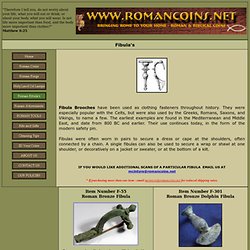
They were especially popular with the Celts, but were also used by the Greeks, Romans, Saxons, and Vikings, to name a few. The earliest examples are found in the Mediterranean and Middle East, and date from 800 BC and earlier. Their use continues today, in the form of the modern safety pin. Fibulas were often worn in pairs to secure a dress or cape at the shoulders, often connected by a chain. A single fibulas can also be used to secure a wrap or shawl at one shoulder, or decoratively on a jacket or sweater, or at the bottom of a kilt. IF YOU WOULD LIKE ADDITIONAL SCANS OF A PARTICULAR FIBULA EMAIL US AT mcintyre@romancoins.net * If purchasing more than one item - email mcintyre@romancoins.net for reduced shipping rates.
Ancient Coins For sale. Roman and Greek. My Trajan Coin. List of Roman emperors. Julius Caesar. Augustus. Augustus (Latin: Imperator Caesar Divi F.

Augustus,[note 1] 23 September 63 BC – 19 August 14 AD) was the founder of the Roman Empire and its first Emperor, ruling from 27 BC until his death in 14 AD. [note 2] After the demise of the Second Triumvirate, Augustus restored the outward facade of the free Republic, with governmental power vested in the Roman Senate, the executive magistrates, and the legislative assemblies. In reality, however, he retained his autocratic power over the Republic as a military dictator. By law, Augustus held a collection of powers granted to him for life by the Senate, including supreme military command, and those of tribune and censor.
Battle of the Teutoburg Forest. Map showing the defeat of Varus in the Teutoburg Forest.

Tiberius. Caligula, Tiberius' grand-nephew and adopted grandson, succeeded Tiberius upon his death.[4] Early life[edit]
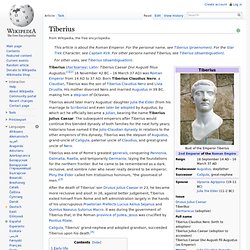
Caligula. "Caligula" (Latin: Gaius Julius Caesar Augustus Germanicus;[1]) was the popular nickname of Gaius (31 August 12 AD – 22 January 41 AD), Roman emperor from 37 AD to 41 AD.
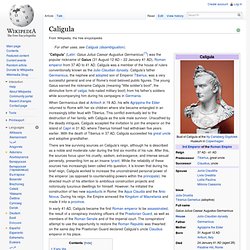
Caligula was a member of the house of rulers conventionally known as the Julio-Claudian dynasty. Caligula's father Germanicus, the nephew and adopted son of Emperor Tiberius, was a very successful general and one of Rome's most beloved public figures. The young Gaius earned the nickname Caligula (meaning "little soldier's boot", the diminutive form of caliga, hob-nailed military boot) from his father's soldiers while accompanying him during his campaigns in Germania.
When Germanicus died at Antioch in 19 AD, his wife Agrippina the Elder returned to Rome with her six children where she became entangled in an increasingly bitter feud with Tiberius. Ostrogothic Kingdom. Lombards. 8th-century Lombard sculpture depicting female martyrs based on a Byzantine model.
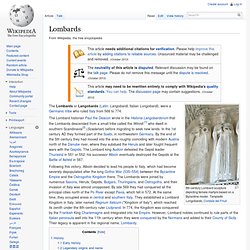
Tempietto Longobardo, Cividale del Friuli The Lombards or Langobards (Latin: Langobardī, Italian Longobardi), were a Germanic tribe who ruled Italy from 568 to 774. Charlemagne. Mausoleum of Theoderic. Entrance to the Mausoleum of Theoderic.
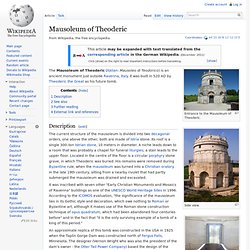
Side view. Etruscan civilization. Etruscan civilization is the modern name given to a civilization of ancient Italy in the area corresponding roughly to Tuscany, western Umbria, and northern Latium.
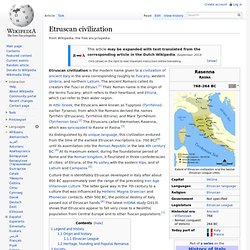
The ancient Romans called its creators the Tusci or Etrusci.[1] Their Roman name is the origin of the terms Tuscany, which refers to their heartland, and Etruria, which can refer to their wider region. As distinguished by its unique language, this civilization endured from the time of the earliest Etruscan inscriptions (ca. 700 BC)[4] until its assimilation into the Roman Republic in the late 4th century BC.[4] At its maximum extent, during the foundational period of Rome and the Roman kingdom, it flourished in three confederacies of cities: of Etruria, of the Po valley with the eastern Alps, and of Latium and Campania.[5] Culture that is identifiably Etruscan developed in Italy after about 800 BC approximately over the range of the preceding Iron Age Villanovan culture. Legend and history[edit] Origin and history[edit] Siena. Siena (Italian pronunciation: [ˈsjɛːna] ( ); in English sometimes spelled Sienna) is a city in Tuscany, Italy.

It is the capital of the province of Siena. The historic centre of Siena has been declared by UNESCO a World Heritage Site.[2] It is one of the nation's most visited tourist attractions, with over 163,000 international arrivals in 2008.[3] Siena is famous for its cuisine, art, museums, medieval cityscape and the Palio, a horse race held twice a year. History[edit] Siena, like other Tuscan hill towns, was first settled in the time of the Etruscans (c. 900–400 BC) when it was inhabited by a tribe called the Saina. Middle Ages. House of Medici. The House of Medici (/ˈmɛdɨtʃi/ MED-i-chee; Italian pronunciation: [de ˈmɛːditʃi]) was a political dynasty, banking family and later royal house that first began to gather prominence under Cosimo de' Medici in the Republic of Florence during the late 14th century.
The family originated in the Mugello region of the Tuscan countryside, gradually rising until they were able to fund the Medici Bank. The bank was the largest in Europe during the 15th century, seeing the Medici gain political power in Florence — though officially they remained citizens rather than monarchs. Their wealth and influence initially derived from the textile trade guided by the guild of the Arte della Lana. Like other signore families they dominated their city's government, they were able to bring Florence under their family's power, allowing for an environment where art and humanism could flourish. The Medici Bank was one of the most prosperous and most respected institutions in Europe.